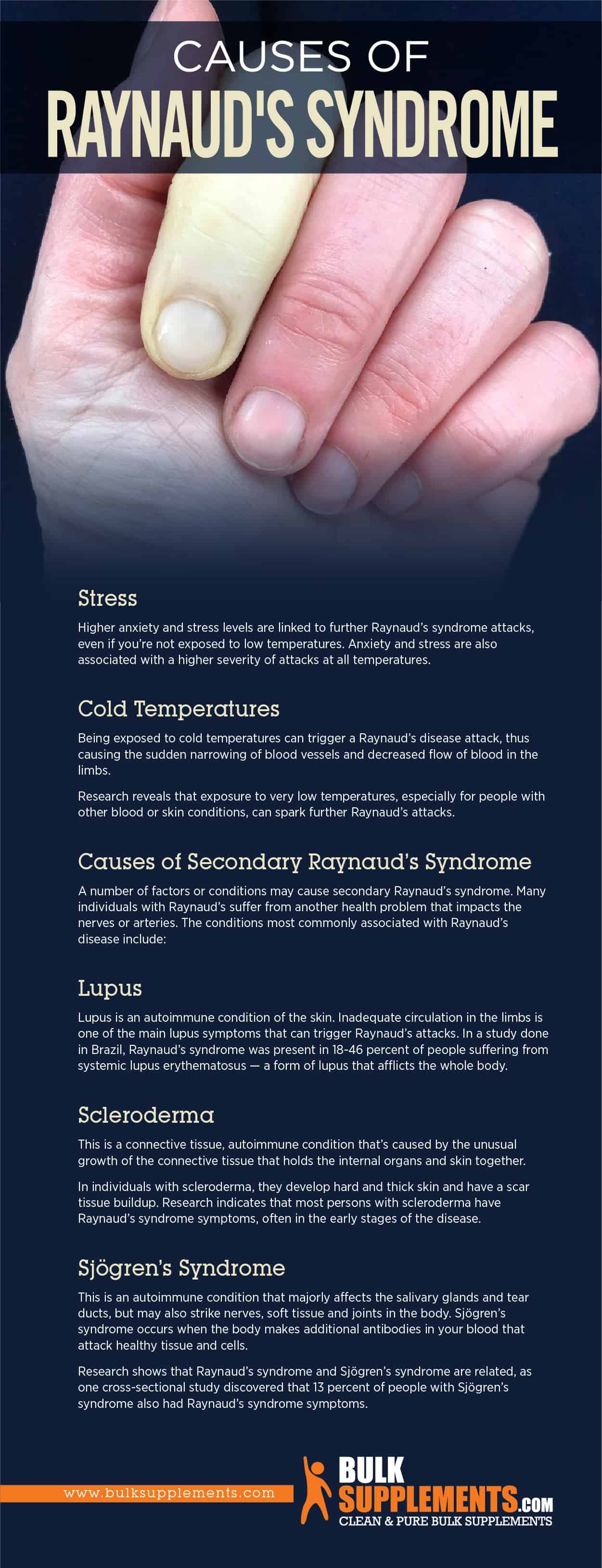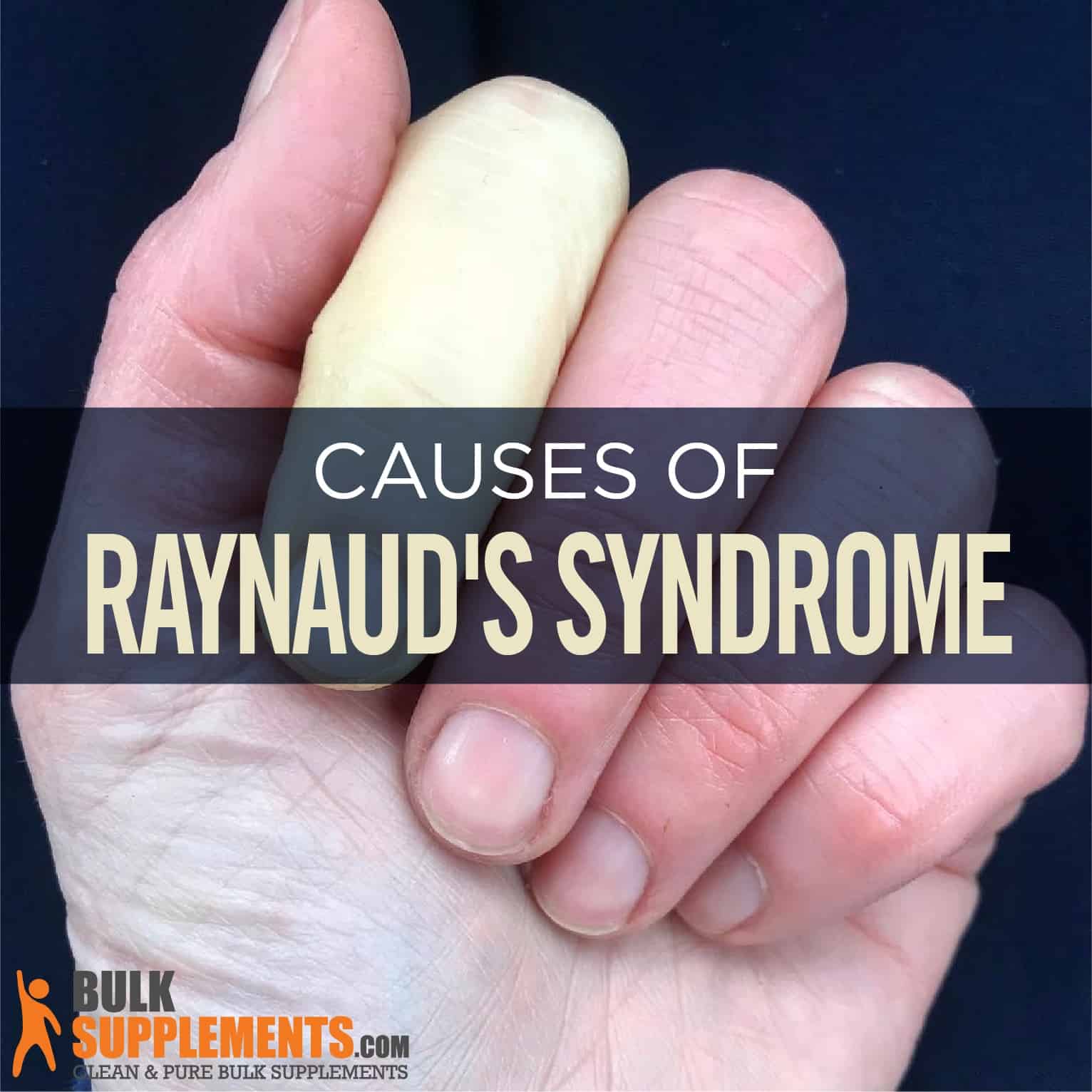What is Raynaud’s Syndrome?
Raynaud’s syndrome, Raynaud’s disease, Raynaud’s phenomenon or just Raynaud’s is a disease of the blood vessels, normally in the toes and fingers. It causes blood vessels to become more narrow than normal during exposure to cold temperatures or stress. The narrowed vessels stop blood from getting to the surface of your skin, which causes affected areas (toes and fingers) to look white, blue and then red (x). Around 5 percent of people in the U.S. suffer from Raynaud’s syndrome (x).
Raynaud’s syndrome was first diagnosed by a French physician named Maurice Raynaud. Raynaud described 25 patients whose hands and feet changed color when exposed to stress or cold. Twenty of them were female (x).
Raynaud’s syndrome often develops by itself. In that case, it’s known as primary Raynaud’s disease — a fairly common disorder that afflicts more women than men. Most individuals with primary Raynaud’s disease don’t experience any further complications. Primary Raynaud’s syndrome typically affects teenage girls and young women, but it may also affect men, children, babies, and the elderly. It occasionally runs in families.
Raynaud’s syndrome is also associated with other conditions, including scleroderma and, rarely, lupus. When this occurs, it’s known as secondary Raynaud’s syndrome.
Causes of Raynaud’s Syndrome
A variety of factors may lead to primary or secondary Raynaud’s syndrome:
Causes of Primary Raynaud’s Syndrome
While what causes primary Raynaud’s disease is unknown, there are certain triggers that may result in an attack, including:
Stress
Higher anxiety and stress levels are linked to further Raynaud’s syndrome attacks, even if you’re not exposed to low temperatures. Anxiety and stress are also associated with a higher severity of attacks at all temperatures (x).
Cold Temperatures
Being exposed to cold temperatures can trigger a Raynaud’s disease attack, thus causing the sudden narrowing of blood vessels and decreased flow of blood in the limbs.
Research reveals that exposure to very low temperatures, especially for people with other blood or skin conditions, can spark further Raynaud’s attacks (x).
Causes of Secondary Raynaud’s Syndrome
A number of factors or conditions may cause secondary Raynaud’s syndrome. Many individuals with Raynaud’s suffer from another health problem that impacts the nerves or arteries. The conditions most commonly associated with Raynaud’s disease include:
Lupus
Lupus is an autoimmune condition of the skin. Inadequate circulation in the limbs is one of the main lupus symptoms that can trigger Raynaud’s attacks. In a study done in Brazil, Raynaud’s syndrome was present in 18-46 percent of people suffering from systemic lupus erythematosus — a form of lupus that afflicts the whole body (x).
Scleroderma
This is a connective tissue, autoimmune condition that’s caused by the unusual growth of the connective tissue that holds the internal organs and skin together.
In individuals with scleroderma, they develop hard and thick skin and have a scar tissue buildup. Research indicates that most persons with scleroderma have Raynaud’s syndrome symptoms, often in the early stages of the disease (x).
Sjögren’s Syndrome
This is an autoimmune condition that majorly affects the salivary glands and tear ducts, but may also strike nerves, soft tissue and joints in the body. Sjögren’s syndrome occurs when the body makes additional antibodies in your blood that attack healthy tissue and cells.
Research shows that Raynaud’s syndrome and Sjögren’s syndrome are related, as one cross-sectional study discovered that 13 percent of people with Sjögren’s syndrome also had Raynaud’s syndrome symptoms (x).
Rheumatoid Arthritis
This is an autoimmune condition of the joints that may cause swelling in or around some joints, including those in the hands.
Other symptoms of rheumatoid arthritis include difficulty moving normally and joint pain, as well as muscle stiffness and aches. According to research, rheumatoid arthritis is one of the conditions associated with Raynaud’s syndrome (x).
Blood Disorders
Blood vessel disorders that decrease blood flow are linked to Raynaud’s disease as well. For example, cryoglobulins is a blood condition that’s triggered by abnormal blood proteins. For people with this condition, cold temperatures may trigger flare ups and cause clumps in their blood vessels.
Burger’s Disease
This condition affects blood vessels in the legs and arms. It makes them swell, thus stopping blood flow and triggering blood clot formation. Burger’s disease causes Raynaud’s disease symptoms like cold feet and hands, changes in skin color, painful sores and pain in the limbs (x).
Atherosclerosis
This is a vascular or heart problem that develops when blood vessels become stiff and thick. Numbness in the legs and arms is one of the most common symptoms of both Raynaud’s syndrome and atherosclerosis.
Since atherosclerosis affects the blood vessels, experts have discovered that it’s associated with vasospasm, which slows down blood flow and causes Raynaud’s syndrome symptoms (x).

Symptoms of Raynaud’s Syndrome
Raynaud’s syndrome accompanies a variety of symptoms, including (x):
Pain, Coldness and Numbness
Inadequate oxygenated blood in your fingers causes these sensations. Numbness is the feeling that your fingers have “gone to sleep.” Your body might also respond to emotional stress in the way it tends to react to cold.
Skin Color Changes
Toes, fingers or sometimes the lips, nose and ears turn white because there’s no blood flow (pallor). The oxygen in the blood left in the tissues disappears, turning the affected area blue (cyanosis). When new oxygen-rich blood comes back to the affected area, it typically turns bright red.
Gangrene and Skin Ulcers
For people with Raynaud’s attacks that last a while or those with severe undiagnosed Raynaud’s disease, painful, slow-healing sores can develop in the fingertips. In uncommon cases, a longstanding lack of oxygen in the tissue can cause gangrene. This is usually insufficient blood flow to a body part, thus causing tissue death.
Living with Raynaud’s
When it comes to managing Raynaud’s syndrome, it’s important to take a proactive approach to your treatment. Once a Raynaud’s syndrome attack has started, you can shorten its length with the following tips:
Control Hand Temperature
Avoid drastic changes in temperature. Warm your feet or hands in warm water. Avoid hot water. Make sure your office is warm and take regular breaks to rub your hands together.
Stay Dry
Since sweat cools on your skin, it can cause an attack. Wear long underwear, absorbent exercise gear, socks and gloves. Make sure your skin and hair are dry before leaving the gym.
Lower Stress
For some individuals with Raynaud’s syndrome, stress and anxiety — minus any decrease in temperature — can trigger an attack. Deep breathing, yoga and meditation are amazing relaxation techniques. Aerobic exercise, Tai Chi and cognitive behavioral therapy are all effective ways to ease tension.
Supplements for Raynaud’s Treatment
Some dietary supplements can benefit people with Raynaud’s syndrome symptoms. They include:
Evening Primrose Oil
Evening primrose oil can support healthy skin, ease menopause and PMS symptoms and promote heart health.
Take 1,000 mg of evening primrose oil (1 softgel) 1-3 times a day, or as suggested by your doctor. This supplement is best taken with food.
Omega-3 Fatty Acids
Omega-3 fatty acids provide the foundation for creating hormones that control blood clotting, relaxation and contraction of artery walls, as well as inflammation.
Due to these properties, omega-3s may help to prevent stroke and heart disease, control rheumatoid arthritis, eczema and lupus and may help protect against cancer and other diseases.
Take 3 soft gels of omega-3-6-9 once or twice per day, or as instructed by your healthcare provider.
Fish Oil
The essential fatty acids contained in fish oil support heart health. This supplement is the only bioavailable source of omega-3s.
The recommended serving size for fish oil is two capsules. Take them twice or thrice a day.
Ginkgo Biloba
Gingko biloba is an antioxidant that’s believed to improve mood, focus and overall mental health. It may also help control age-related cognitive decline.
It’s suggested that you take 175 mg of ginkgo biloba powder up to three times daily, based on your intended effects. Never take more than 525 mg under any circumstances.
The Bottom Line
Raynaud’s syndrome is an uncommon blood vessel condition, typically developing in the toes and fingers. It causes the narrowing of blood vessels when you’re feeling cold or stressed.
Primary Raynaud’s syndrome occurs by itself. There’s no known cause. There’s also secondary Raynaud’s disease, which results from limb injuries, other health conditions or certain medications.
Individuals in colder climate regions are at a higher risk of developing Raynaud’s syndrome. The condition is also more common among women, people over age 30 and those with a family history of Raynaud’s syndrome.
During an attack, the hand and foot blood vessels tighten. This occurrence causes them to feel numb and cold, later appearing white or blue. An attack almost always lasts just a few minutes. In some cases, however, it may last over an hour.
When blood flow resumes and the toes or fingers warm up, they might turn red and start to hurt and throb. Raynaud’s syndrome rarely affects the ears or nose.
Raynaud’s syndrome treatment can include medications to keep blood vessels open. Moreover, there are certain simple steps you can take on your own, such as keeping feet and hands warm during cold weather, soaking your hands in lukewarm water as soon as an attack occurs and avoiding certain triggers like stress and certain medications.


